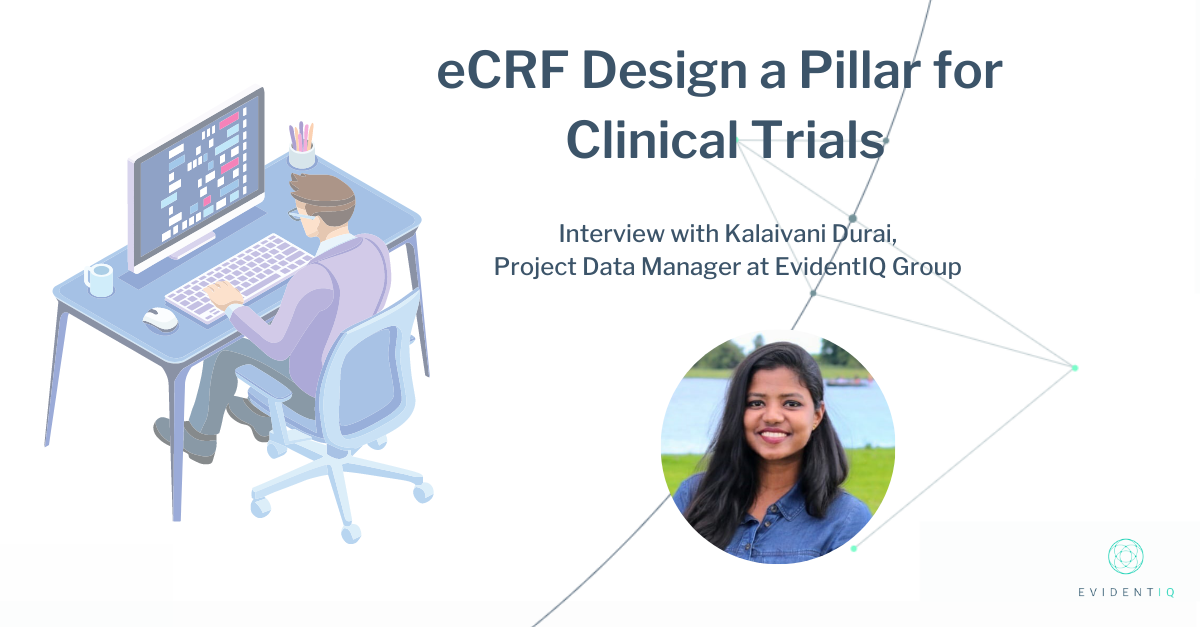I’m Sabine Birkner, Outbound Marketing Manager at EvidentIQ and I recently met with Kalaivani Durai, Project Data Manager at XClinical, part of the EvidentIQ Group.
Data is the linchpin for the billions of dollars dedicated to medical studies—and eCRF is the main collection vehicle for that data. A high-quality eCRF design is therefore as important as the data itself and requires extensive planning and attention to detail. The ideal features of an eCRF, like all good design, should facilitate both ease of use and high-quality results.
More plainly, an eCRF (electronic case report form) is a software system used to collect data in a clinical study. Commonly, eCRFs are web-based applications containing various data forms and fields designed to receive data in clinical trials or observational studies.
The following interview will give us a deeper look into eCRF importance, as well as an insight on the EvidentIQ Way.
Sabine: With all your experience on the topic, what are some important design practices that you can share with us?
Kalaivani: eCRF design is a complex task, with a multitude of resources on the topic. Here are my top tips to streamline processes and maintain high quality:
- Create your eCRF specifications within a software design tool that allows eCRF build directly from the study protocol and provides the annotated eCRF as an output.
2. Maintain the quality and integrity of the data:
- Design the eCRF with the primary and secondary safety, efficacy related endpoints in mind, as the main goal of the study data collection.
- Do not collect duplicate data or data that is not necessarily required for the study
- Include a multidisciplinary team finalizing the design. (Data Managers, Statisticians, Safety department)
3. Maintain consistency in design and eCRF structure:
- The layout must be simple and user friendly
- The questions or any text on the eCRF must be clear and easily understandable for the user
- Sectioning/ grouping the questions on the eCRF depending on related questions
- For Questionnaires, try replicating the original paper form layout as much as possible on the eCRF
- Decide the appropriate type of answer field. Instead of free texts, use predefined options wherever possible
4. Build static forms first, then add edits. Experience has shown us that changes happen and the cost of these are minimal if the edit checks have not been programmed yet.
5. Limit your data validation plan to the most relevant edit checks to avoid the cost of over-programming your eCRF.
6. Employ a thorough user acceptance testing (UAT) of the eCRF throughout the process. The first UAT should come after the static forms are built, again after the edit checks are incorporated, and prior to production.
7. Remember to design for the end user, primarily the study site personnel, so consider them as your customers and think about their circumstances and needs.
"eCRF design is a complex task [...] where you need to maintain high quality data"
Sabine: How can people know which eCRF Software designer tool is right for their study?
Kalaivani: Though it’s tempting to create an eCRF with the editing tools included in your office suite, it’s not ideal. Use a superior eCRF software to design eCRFs, with feature sets that include software design tools. These tools can help jump start your eCRF design and creation via template libraries. As a result, you can customize existing, proven eCRFs, with built-in standards support and specifically designed editors.
Sabine: Which features are the most important when choosing eCRF software?
Kalaivani: I would recommend going for one that includes:
- An eCRF library that facilitates CRFs reuse across studies
- The ability to meet all regulatory requirements
- Support for industry standards
- Functions that automate the creation of annotated CRF and data validation plan
- Ease of use and flexibility for the size / complexity of your clinical studies
- No prior programming knowledge, including cross form/cross visit edit checks
- Support and facilitate changes during the course of the study
And do not forget: Straight-forward version control for amendments.
Sabine: What are the standards the eCRF needs to comply with?
Kalaivani: A well-designed eCRF should always comply with the major data and electronic standards and pave the way for regulatory submission. The FDA and the PMDA have adopted Clinical Data Interchange Standards Consortium (CDISC) standards for both data exchange and submission data. CDISC provides CDASH conventions to collect data consistently across studies to provide clear traceability of submission data into the Study Data Tabulation Model (SDTM).
For example, we at EvidentIQ recommend using CDASH elements pre-mapped to the CDISC SDTM standard and CDASH elements that are combined on different pages to provide flexible eCRF form design. In addition to this, the benefits of utilizing internal standards to create your eCRF are:
- Easy reuse of forms which in turn speeds up trial design (adverse events, concomitant medication, medical history, etc.) Consistent use of factors such as metadata terminology, code lists, and eCRF layout will allow for faster and easier eCRF creation.
- Incorporating the regulatory standards into your internal standards will create efficiencies not only in the eCRF build but also with data extraction and analysis.
To comply "we at EvidentIQ recommend using CDASH elements pre-mapped to the CDISC SDTM standard"
Sabine: Paper or electronic format. Which solution is better?
Kalaivani: Definitely electronic. Using an eCRF is the logical step to improve data quality. With modern technology we can replicate most of the qualities of paper better than ever. But a shift from a paper-based case report form to an electronic case report form can be a challenge.
Sabine: Can you tell us more about how does the XClinical/EvidentIQ eCRF work?
Kalaivani: With our eCRF design tool, you can produce eCRF designs, document links, SDTM Tabulation and more to live in a single intuitive interface for your whole team. The tool includes an SDTM reviewer as perfect add-on to visualize your SDTM data. Furthermore, the composer contains a library functionality that allows the reuse of CRFs across different studies. This saves time and it also reduces the quality checks costs.
- The tool automatically ensures compliance with the international CDISC ODM standard format, enabling the eCRF and database design to be exchanged within other systems and organizations (for example between sponsors and CROs).
- Changes to design after Go live can be easily implemented as amendments using the composer and is also version controlled.
- Allows generation of Annotated CRFs, Blank CRFs, SAS transforms, Data Validation Plan from the CRF design. This helps in previewing the CRF and adapting the design even before uploading into the EDC system.
- In combination with an EDC system that can import CDISC ODM metadata, the Composer supports the automatic setup of an EDC database.
With an EDC system that does not have this capability, Composer still provides the best possible, unambiguous eCRF specifications, including an underlying validated database and data validation plan. This guarantees the most efficient communication between different teams and organizations.
Sabine: Any last words?
Kalaivani: Just to mention that efficient eCRF design is pillar to ensuring the success of any clinical research study and it impacts every moving part and component. Keeping these design tips in mind will make your eCRFs more effective by collecting consistent and valid data that requires fewer manual queries and meets regulatory compliance. Employing an effective design process can dramatically streamline workflows and better serve customers, as well as save time and lower costs.
"eCRF design is pillar to ensuring the success
of any clinical research study"
Sabine: Thank you for your time 😊
For more information and a deeper understanding on this topic click here.
For a free demo contact us at verena.frank@xclinical.com





























